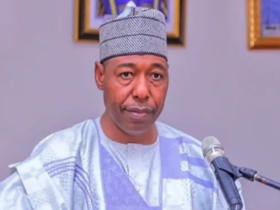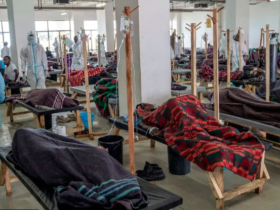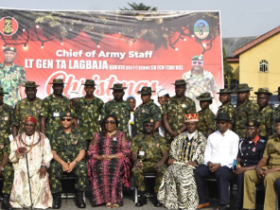Israel struck Gaza targets Sunday in its war on Hamas sparked by the October 7 attacks, as international concern deepened over mounting civilian deaths on the third day of fighting after a truce ended.
More than 15,500 people have been killed in the besieged Palestinian territory, according to the Hamas-run health ministry, in more than eight weeks of combat and heavy bombardment.
Israeli air and artillery strikes hit Gaza’s northern frontier with Israel, throwing thick clouds of smoke and dust into the sky.
The Israeli army reported 17 rocket salvos from Gaza into Israel on Sunday, adding that most were intercepted and there was only slight material damage.
Israel said two of its soldiers had died in combat, the first since the week-long truce expired on Friday.
Hospitals in southern Gaza overflowed with dead and wounded, some crying out in pain.
“I am running out of ways to describe the horrors hitting children here,” James Elder, a spokesman for the United Nations children’s agency UNICEF, said in a video from Nasser hospital in Khan Yunis.
“This is the worst bombardment of the war right now in south Gaza. I am seeing massive child casualties,” he said in a remarks on the social media platform X.
Nine-year-old Huda, who was wounded in the head, arrived at the Deir al-Balah Hospital with an International Committee of the Red Cross convoy bringing casualties from northern Gaza.
“She doesn’t answer me any more,” her father Abdelkarim Abu Warda said, sobbing.
No safe place
The war broke out when Hamas militants burst through Gaza’s militarised border into Israel on October 7 and killed about 1,200 people, mostly civilians, while also taking around 240 hostages, according to Israeli authorities.
Vowing to destroy Hamas, Israel responded with an air and ground campaign that Gaza authorities say has killed mostly women and children.
The seven-day pause in fighting, brokered by Qatar with support from Egypt and the United States, led to the release of 80 Israeli hostages in exchange for 240 Palestinian prisoners.
More than two dozen other captives were freed from Gaza outside the scope of the truce deal.
The Israeli military said it had carried out around 10,000 air strikes since the war started.
The army also said it had located more than 800 shafts to Hamas tunnels and “destroyed” about 500 of them, adding that many were near or inside civilian buildings such as schools and mosques.
United Nations High Commissioner for Human Rights Volker Turk voiced alarm that hundreds of thousands of Gazans were “being confined into ever smaller areas” in the south of the territory.
“There is no safe place in Gaza,” he said.
The Israeli military said a drone strike had “eliminated” five Hamas militants.
Fighter jets and helicopters had also struck “tunnel shafts, command centres and weapons storage facilities” while naval forces hit Hamas vessels and weapons, it said.
Fighting also flared on Israel’s northern border with Lebanon.
The Israeli army said it had launched artillery strikes in response to cross-border fire, and its fighter jets hit a number of targets linked to Lebanese militant group Hezbollah.
Iran-backed Hezbollah said it had launched several attacks on Israeli positions, including a missile strike on a military vehicle.
‘Too many’ innocents killed
Israel’s ally the United States, which provides it with billions of dollars in military aid annually, has intensified calls for the protection of Gaza’s civilians.
“Too many innocent Palestinians have been killed,” Vice President Kamala Harris told reporters at UN climate talks in Dubai.
Israeli government spokesman Eylon Levy said that the blame for the deaths lay with Hamas and those killed “would still be alive” had the group not carried out the October 7 attacks.
In a new estimate, OCHA said around 1.8 million people in Gaza, roughly 75 percent of the population, had been displaced, many to overcrowded and unsanitary shelters.
Gazans are short of food, water and other essentials, and the aid reaching them is “a drop in the ocean of needs,” said Adnan Abu Hasna, a spokesman for the UN agency for Palestinian refugees, UNRWA.
Pope Francis deplored “so much suffering in Gaza”, and urged those involved to reach a new ceasefire deal.
Return them safely
On Saturday Prime Minister Benjamin Netanyahu’s office said Israeli negotiators were being withdrawn from Qatar “following the impasse in the negotiations” aimed at renewing the truce.
As fighting continues, Hamas has ruled out more hostage releases until a permanent ceasefire is agreed.
“The price to pay for the release of Zionist (Israeli) prisoners will be the release of all our prisoners -– after a ceasefire,” Saleh al-Aruri, deputy head of Hamas’s politburo, said on Saturday, referring to thousands of Palestinians held in Israeli jails.
There are still 137 hostages held in Gaza, Israel’s army said.
“We will not endanger the abductees and we will do everything to return them safely,” military spokesman Daniel Hagari said.
Netanyahu said the war would continue “until we achieve all its aims” — among them freeing the hostages — and that soldiers had prepared during the truce “for total victory against Hamas”.
Britain’s defence ministry said that it would conduct surveillance flights over Israel and Gaza “in support of the ongoing hostage rescue activity”.
US Defence Secretary Lloyd Austin on Saturday drew on his experience fighting the Islamic State group in urging Israel to protect non-combatants.
“The lesson is that you can only win in urban warfare by protecting civilians,” he told a forum in California.
Most Gazans are trapped, but an Egyptian border crossing, after a closure on Friday, reopened to enable 880 foreign and dual nationals to cross on Saturday along with 13 injured people, the UN said.












Leave a Reply